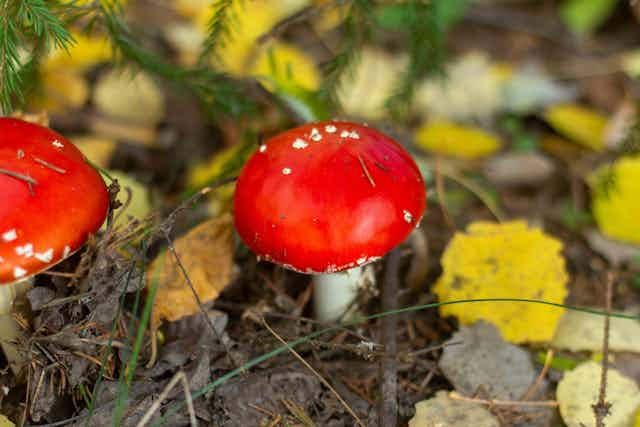I cannot stop writing poems! … They come from the vocabulary of woods and animals and earth.
From a letter from Sylvia Plath to her mother, 1956
Popular perceptions of Sylvia Plath tend to dwell on a deeply troubled version of the young poet due to her well-documented difficulties with depression and the morbid imagery found in some of her poetry. So the idea that nature inspired her writing may come as a surprise.

This despairing Plath is a far cry from the poet I have come to know and admire – a poet who writes about the simple beauty of meadows and the tenacity of fungi as well as the splendours of rugged wilderness.
Plath’s fascination with the natural world began in childhood, as she makes clear in her essay Ocean 1212-W, in which she details the importance of the sea to her poetic imagination. This interest in nature continued into adulthood, when she read the work of biologists such as Rachel Carson, whom she writes about in her letters.
Any other poet with this background would at least be credited with a passing interest in the natural world. However, Plath’s untimely death by suicide has skewed much interpretation of her poetry. The well-versed argument that Plath only uses nature in her poetry as a “mirror to look deeper into herself, has pervaded critical writing on her work from the 1960s to the 21st century.
It is this blinkered view of Plath which has led to an oversight of the ecological significance of her poetry. As we move past the 60th anniversary of Plath’s death, it is time to embrace more nuanced interpretations of her work and to reimagine what her poetic legacy might look like.
Grand-scale natural beauty
Plath loved the vast landscapes of national parks as well as smaller-scale wildernesses like those of England’s Yorkshire moors. In letters from 1956, she describes "the great luminous emerald lights” of the Yorkshire countryside, concluding that she has “never been so happy” in her life as among the “wild, purple moors”.
These excerpts from her letters resonate with the celebratory assertion in the poem Wuthering Heights that “there is no life higher than the grasstops or the hearts of sheep”.
She found similar beauty in the national parks of America and Canada, which she visited in the summer of 1959. In letters from this period, she remarks that she has never seen “such wonderful country anywhere in the world”. No doubt these experiences inspired the sublime depiction of the “dominance of rocks and woods” and “man-shaming clouds” in the poem Two Campers in Cloud Country as well as the spectacular “splurge of vermilions” she describes in the sunsets over Algonquin National Park in Canada.
Beauty in smaller places
However, it is not these grand poetic depictions of the natural world which resonate the most with me. Even the most ardent city enthusiast can pause for a moment of wonder in front of millennia-old mountains, but few among us can render the seemingly prosaic aspects of the natural world with the lyrical grandeur evident in much of her writing.
Plath’s journal entries, written from the Yaddo writers’ retreat in upstate New York in the autumn of 1959, demonstrate a sensitive interest in small details of the natural world which many deem mundane or insignifcant. Coming across a patch of toadstools in the gardens at Yaddo, she observes these “round battering rams” with their “orange ruddy tops” and “pale lemon stems”.
Her poem Mushrooms captures much of this detail with the “soft fists” of the mushrooms which heave aside the garden “bedding”. “Nobody sees us”, the collective voice of the mushrooms in the poem declares, before claiming:
We shall by morning
Inherit the earth.
Our foot’s in the door.
In this poem, Plath emphasises the magnificent elements of the natural world that many of us overlook or disregard. She highlights the dangers, as environmental historian William Cronon suggests, in appreciating only the kind of big majestic landscapes found in national parks. By doing so, Plath infers, we neglect the significance of nature in more familiar and ordinary places.
While Plath may well be remembered for the melancholic despair of Sheep in Fog or the angry, flame-haired women of poems such as Lady Lazarus, it is also important that she is remembered for the ecological significance of her writing.

Despite personal difficulties in her marriage and worsening mental health, Plath’s interest in nature continued to inspire much of her late poetry. Her 1962 poem Among the Narcissi, for example, captures a poignant but ordinary moment of kinship between an elderly man, who loves the “little flocks” of flowers in his garden, and the flowers themselves who “look up” from the flowerbeds towards him, “like children”.
Just like the small flock of lilac crocuses I was surprised to find growing amid the broken paving in my own much-neglected garden, Plath’s poetry continually surprises me with its uncanny ability to see the unseen in nature. Such deeply felt attunement to nature deserves to be recognised as part of the rich and multifaceted legacy of her work.

